| Thomas
7th Baron Scales |
| Robert de
Scales’s brother Thomas (1397-1460) took
over the title 7th Baron Scales on the death of
his elder brother Robert, when he had only just
come of age. He was the last and perhaps the most
distinguished of the Barons Scales, his son
Thomas (c.1435-c.1440) predeceasing him. He
married Emma (Ismayne, Esmania) Whalesborough,
daughter of Sir Simon Whalesborough of Cornwall.
He was a wealthy man and, in addition to
Middleton and Newselles, held the Manor of
Rivenhall in Essex and many other estates in
Norfolk and elsewhere. |
| He behaved
gallantly in the wars against France and played a
major role in Henry V’s 1421 campaign,
including the sieges of Dreux and Meaux. Henry
was to die the following year from dysentery
probably caught during the latter siege. In 1422
he fought in Normandy against Joan of Arc in the
Loire campaign. |
| He was at the
battle of Verneuil in 1424 (sometimes called the Second
Agincourt), where the English under the Duke
of Bedford won a crushing victory over the Scots
and French. In 1424-5 he fought alongside John
Fastolf (Shakespeare’s probable model for
Falstaff) to recapture the fortress at Maine. In
1426, when in France (again with the Duke of
Bedford, regent to the young Henry VI), he was
elected Knight of the Garter at St.
George's feast at Windsor. |
| He saw action
against Joan of Arc again in the Siege of
Orléans (1428-9), a turning point in the Hundred
Years War and the first major French success
after Agincourt. He was taken prisoner but a
ransom was paid and he was released. This is
discussed by the Duke of Bedford in Shakespeare's
Henry VI Part 1 (see the next page). He evidently
commanded a corps of 728 archers and about 50
infantry at the siege of Saint-Denis in 1435. By
1441 he was Seneschal of Normandy with a seal of
six scallop shells and the circumscription Sir
Thomace de Scalis et de Neucellis Senescalli
Normanice. All in all he was one of the
principal English commanders in the last twenty
years of the Hundred Years War. |
| In 1450 Thomas
fought against Jack Cade, leader of the popular
revolt known as the Kent Rebellion. This
act is recalled when he appears briefly in
Shakespeare's Henry VI Part 2 (see the next page
but one). By 1451, a Lancastrian supporter, he
was said to be in high favour with Henry VI and
his queen Margaret of Anjou. |
| In 1460, the
Yorkist Earls of March, Warwick, and Salisbury
invaded from Calais and Thomas, assisted by Lord
Hungerford and other eminent Lancastrians,
secured the Tower of London for the King. His
defence of The Tower against the Yorkists did not
go well, as his weaponry mainly succeeded in
killing civilians and setting fire to their
properties, but he managed to hold out for a
while. Warwick led his forces north, where they
triumphed at the Battle of Northampton. The Queen
escaped to Harlech Castle in north Wales and the
King was taken to London, where Salisbury's
forces has ended the resistance at The Tower by
starving the garrison and battering the outer
defences with heavy cannon. Thomas had tried to
escape by boat with three others, but was
recognised by an angry mob and murdered 'with
many darts and daggers'. He was buried at the
Church of St. Mary Overie, now Southwark
Cathedral. |
| It was an ignominious
end for a proud, veteran soldier with a
reputation for occasional brutality, who was
nonetheless apparently known by his men as 'good
old Lord Scales'. |
| Middleton
Towers |
| It was Thomas
who in 1455 began the construction of what is now
Middleton Towers. The large, three storey
gatehouse with corner turrets dates from this
time. It was unfinished by the time of his death
in 1460 and the work was probably completed by
his daughter Elizabeth and son-in-law Anthony
Woodville. By the 18th century the site was
derelict and very little of the 15th century
house remained other than the gatehouse itself.
The remainder of the present structure dates from
the second half of the 19th century, when the
gatehouse was also restored. The present site is
worth studying on Google Earth - the
moat and layout of the buildings are very clear. |
| Elizabeth
de Scales |
| Because of his
son Thomas’s early death, Thomas the 7th
Baron's heir was his daughter Elizabeth
(c.1436-1473), then about 24 and married to Sir
Henry Bourchier, son of Henry Bourchier, 1st Earl
of Essex. The barony also passed to her; she
became 8th Baroness Scales and one of the
wealthiest heiresses in England. She had had no
children by the time Henry died and by 1462 she
was remarried to Anthony Woodville, 2nd Earl
Rivers, son and heir of Richard Woodville, 1st
Earl Rivers, who was treasurer to Edward IV and
father of Elizabeth Woodville his Queen. The
following year Earl Rivers was summoned to
parliament under the title Lord Scales.
Elizabeth's remarriage is dicussed in
Shakespeare's Henry VI Part 3, when Edward
IV’s brothers George Duke of Clarence and
Richard Duke of Gloucester complain to Edward
about his bestowal of her on the Queen's brother
instead of one of them (see the next page). |
| Elizabeth died
childless in 1473, predeceasing Anthony, and
marking 15 generations and over 400 years of this
branch of the family. In 1473 Edward IV appointed
Earl Rivers Governor of the Prince of Wales'
household and he went with the Prince to Ludlow
Castle. When Edward died in 1483, Rivers
accompanied the Prince, now Edward V, on the way
back to London. However, they were waylaid by the
Duke of Gloucester, who imprisoned Rivers and
then had him beheaded at Pontefract Castle as
part of his path towards becoming King Richard
III. The De Scales peerage fell into abeyance and
the issue of inheritance of the vast estate was
left in dispute. The inheritance issue was
resolved on the accession of Henry VII in 1485
when it was determined that the heirs were
descendants of Robert 3rd Baron Scales via his
daughters Elizabeth and Margaret. |
| The
Heirs of Elizabeth de Felbrigg née Scales |
| The 3rd Baron's
daughter Elizabeth had married Roger de Felbrigg
(1316-1362) from a prominent Norfolk family and
her heirs were her great-granddaughter Helena de
Felbrigg (1399-1426), also heiress of the
Felbrigg family, and her husband William Tyndale
(1397-1426). Helena and William were the
great-grandparents of Sir William Tyndale
(1494-1536), protestant reformer and translator
of the Bible into English (and ultimately
martyred for it). |
| The
Heirs of Margaret Howard née Scales |
| The 3rd Baron's
daughter Margaret had married Robert Howard
(1336-1388) from another prominent Norfolk family
and her heirs were her great-granddaughter
Elizabeth Howard (1410-aft.1475), also heiress of
the Howard family, and her husband John de Vere
12th Earl of Oxford (1408-1462). |
| Robert and
Margaret's son John Howard (d.1436) married
twice. His first wife was Margaret Plaise and
their granddaughter was the abovementioned
Elizabeth Howard. Elizabeth's husband John de
Vere was succeeded by the remaining Earls of
Oxford down to the 20th Earl (1627-1703), where
the line terminated with his daughter Diana.
Diana married Charles Beauclerk (1670-1726), 1st
Duke of St. Albans and illegitimate son of
Charles II and Nell Gwynne. The Dukes of St.
Albans live on with the 14th Duke Murray de Vere
Beauclerk (b.1939). |
| Among the most
distinguished of the line was Edward de Vere,
17th Earl of Oxford (1550-1604), an Elizabethan
courtier, playwright, poet, sportsman and patron
of writers, composers and acting companies. He is
most famous today as the strongest alternative
candidate proposed for the authorship of
Shakespeare's plays. |
| John Howard's
second wife was Alice de Tendering and their
grandson was John Howard 1st Duke of Norfolk
(1420-1485). The Dukes of Norfolk are the premier
Dukes in the Peerage of England and this was the
third and last creation of the title. He was a
close friend and loyal supporter of Richard III,
who ganted him the title and with whom he died at
the Battle of Bosworth. His son Thomas 2nd Duke
of Norfolk (1443-1524) also fought with Richard
at Bosworth, but survived into the Tudor era. |
| Among the 2nd
Duke's nine children by his first wife Elizabeth
Tilney (bef.1447-1497 - he had another eight by
her cousin Agnes, his second wife), was Thomas
Howard 3rd Duke of Norfolk (1473-1544), the
prominent politician in the time of Henry VIII.
His descendants were the Dukes of Norfolk down to
the current 18th Duke Edward Fitzalan-Howard
(b.1956). Among the other children by the 2nd
Duke's first marriage were his son Edmund
(d.1539) and his daughter Elizabeth (1480-1538).
Elizabeth married Thomas Boleyn 1st Earl of
Wiltshire (1477-1539) and one of their children
was Anne Boleyn (c.1507-1536), 2nd wife of Henry
VIII and mother of Elizabeth I. Edmund's first
wife was Jocasta Culpeper (1480-1531) and one of
their children was Catherine Howard (1521-1542),
5th wife of Henry VIII. The rest, as they say, is
history. |
|
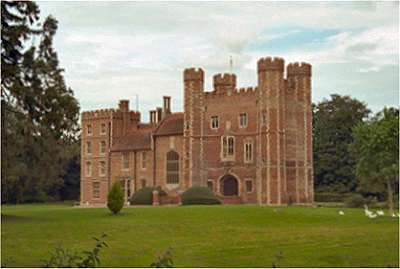 |
| Middleton
Towers |
| |
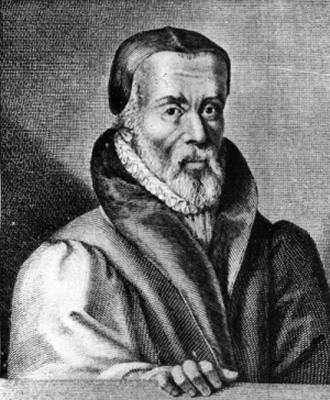 |
| Sir
William Tyndale |
| |
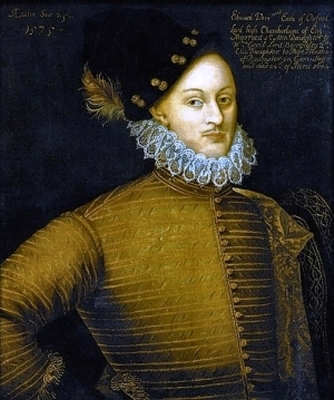 |
| Edward
de Vere, 17th Earl of Oxford |
| |
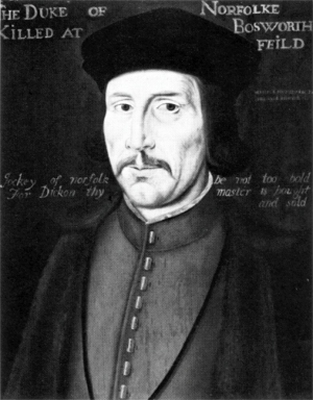 |
| John
Howard, 1st Duke of Norfolk |
| |
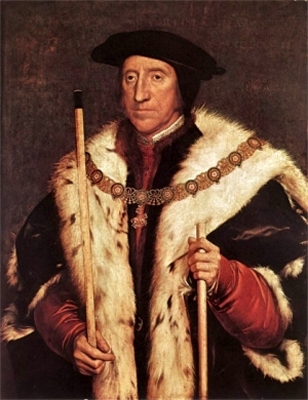 |
| Thomas
Howard, 3rd Duke of Norfolk |
|